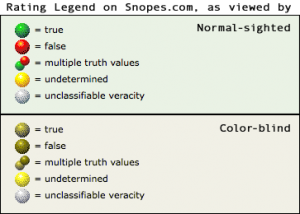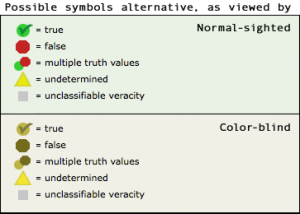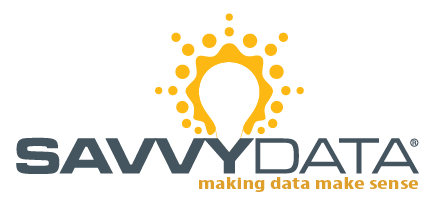[Note: This is the text of a message I sent to the Snopes.com owners, seconding a valid user request per the blog post at waxy.org which itself was a critique on a Netflix chart. These are but two examples of reducing efficacy through poor display choices.]
“David and Barbara, thank you so much for your efforts and diligence over the years with Snopes.com. The Internet is a better place as a result. I have directed hundreds of people to your site as a tool for fighting ignorance. I encourage folks to not believe everything they read, and to make at least the minimal effort of checking Snopes.com before they forward their erroneous (or even malevolent) message.“
 So I was disappointed to learn that you willingly diminish your site’s user experience using red-yellow-green “traffic light” indicators after being informed of the method’s shortcomings (waxy.org). Nearly 7% of males have a form of color blindness that makes it hard to distinguish between your true-or-false indicators. Your FAQ states that you know this, but you stick with the method anyway. You defend your decision with uninformed, flawed assumptions.
So I was disappointed to learn that you willingly diminish your site’s user experience using red-yellow-green “traffic light” indicators after being informed of the method’s shortcomings (waxy.org). Nearly 7% of males have a form of color blindness that makes it hard to distinguish between your true-or-false indicators. Your FAQ states that you know this, but you stick with the method anyway. You defend your decision with uninformed, flawed assumptions.
The color indicator problem is familiar to professionals in the data visualization arena — and so we use easily-implemented alternatives to side-step the whole issue. The following suggestions will work for your color-blind viewers, as well as normal-sighted people that print out your pages on a non-color printer.
The three most common solutions (from least to most different) are:
1. Change the hue or color saturation. For example a slightly lighter green and deeper red makes a huge difference to the color-blind without being too noticeable by normal-sighted viewers. I notice you seem to be doing this on more recent items, but older listings are unchanged.
2. Add a symbol to the bullet. It is very easy place an up/down arrow or a plus/minus sign on top of the colored graphic.
 3. Change the shape of the bullet. Any shape distinction will work, but why not take advantage of traffic symbols people already understand? My recommendation would be a red octagon (stop sign), a yellow triangle (caution), and a green circle (‘go’ traffic light). I believe your viewers would find this even more useful than your current method.
3. Change the shape of the bullet. Any shape distinction will work, but why not take advantage of traffic symbols people already understand? My recommendation would be a red octagon (stop sign), a yellow triangle (caution), and a green circle (‘go’ traffic light). I believe your viewers would find this even more useful than your current method.
Thanks in advance for considering a change of graphics; I hope you find the enclosed ideas constructively suggested.
Sincerely,
Lee Lukehart
Chief Data Visualist
SavvyData

1 thought on “Message to Snopes.com: “About Your Rating Symbols””